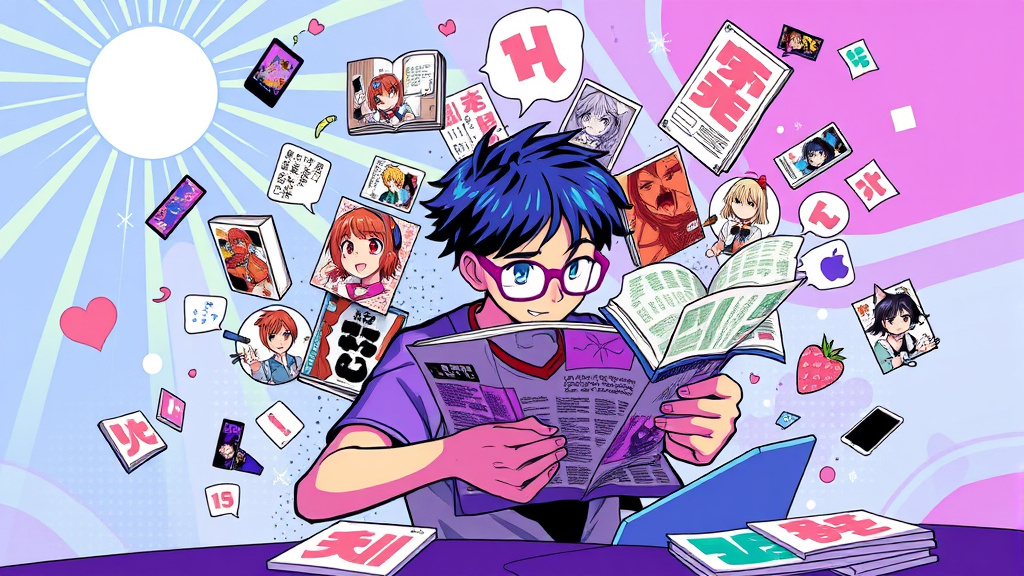When you hear manga en, many immediately think of captivating stories, stunning artwork, and a cultural phenomenon that has transcended borders. Manga en, which refers to Japanese comics or graphic novels, has become a cornerstone of Japanese pop culture and a beloved genre worldwide. This art form goes beyond mere entertainment; it reflects societal values, influences animation and film industries, and inspires countless creators globally. As an accessible yet profound medium, manga en continues to expand its reach and evolve in the digital age, captivating readers of all ages and backgrounds.
The Enduring Appeal of Manga: A Global Phenomenon
Manga en’s enduring appeal hinges on its ability to blend intricate storytelling with visually compelling artwork, creating an immersive experience for readers. Unlike Western comics, manga en often presents serialized narratives that develop characters over many volumes, fostering a deep connection between the audience and the story. This serialized format, combined with its diverse genres—ranging from action and romance to psychological thrillers and slice-of-life—caters to a broad spectrum of interests, making manga en accessible and engaging for everyone.
Beyond its storytelling prowess, manga en resonates culturally because of its reflection of Japanese society—its values, struggles, humor, and philosophies. The widespread popularity of manga en across the globe can be attributed to its universal themes of perseverance, friendship, love, and moral dilemmas, which transcend cultural boundaries. This universal appeal ensures that manga en continues to grow as a powerful form of entertainment, inspiring adaptation into anime, movies, and merchandise worldwide, solidifying its place as a global cultural phenomenon.
 Hình minh họa: manga en – manga reading free website
Hình minh họa: manga en – manga reading free websiteExploring Diverse Genres Within the Manga Universe
One of the unique strengths of manga en is its vast array of genres, each catering to specific tastes and demographics. From shonen (targeted at young boys) to shojo (aimed at young girls), seinen (adult men), and josei (adult women), manga en’s diversity ensures there’s something for everyone. For example, shonen manga like Naruto and One Piece thrill fans with action-packed adventures and hero’s journeys, while shojo manga such as Fruits Basket and Ouran High School Host Club focus on romance and emotional development with a delicate touch.
However, beyond these traditional categories, manga en also explores niche genres such as mecha (robots), sports, horror, fantasy, and historical fiction. Notably, manga en often fuses genres to create unique hybrid stories—think of the dystopian sci-fi in Akira or the supernatural elements in Bleach. This genre flexibility not only showcases manga en creators' artistic innovation but also reflects the complex, layered interests of its readership. Such diversity is a testament to manga en’s adaptability and its ability to evolve with societal shifts, ensuring its continued relevance and freshness.

The Art of Storytelling: Narrative Techniques in Manga
Manga en’s storytelling is distinguished by its mastery of visual and verbal narrative techniques that create a compelling reading experience. Panel layout, pacing, and expressive artwork work in tandem to build tension, evoke emotion, and guide the reader through complex plots seamlessly. Many manga en artists utilize dynamic compositions—speed lines, close-ups, and exaggerated expressions—to heighten drama and action, capturing readers’ attention instantaneously.
Moreover, manga en often employs layered storytelling methods such as internal monologues, symbolic imagery, and flashbacks to deepen character development and thematic richness. This multi-faceted approach not only keeps readers engaged but also encourages active interpretation, as fans analyze subtle cues and symbolic details embedded within the artwork. Key to this artistry is how manga en blurs the line between art and narrative, turning each page into a carefully crafted piece of storytelling that reflects cultural motifs while pushing visual storytelling boundaries.
Cultural Significance of Manga: Reflecting Japanese Society
Manga en serves as a mirror to Japanese society, encapsulating its values, struggles, and identity through stories rooted in local history, traditions, and social issues. Many manga en explore themes such as honor, duty, family, and societal pressure, resonating deeply with Japanese audiences. For instance, works like Rurouni Kenshin reflect Japan’s Meiji-era history, while contemporary manga such as My Hero Academia echoes themes of individualism and resilience relevant to modern Japan.
At the same time, manga en’s cultural significance extends beyond the national borders, offering international audiences a glimpse into Japanese worldview and social norms. From depicting everyday life in Shimanami Tasogare to addressing social anxieties in Tokyo Ghouls, manga en becomes a cultural artifact, allowing readers worldwide to understand and appreciate Japanese society’s nuances. Its influence shapes perceptions of Japan globally, fostering cross-cultural exchange and heightened awareness of the country’s complex social fabric.
Manga's Influence on Animation and Film
Few art forms have as profoundly impacted animation and film as manga en. Many iconic anime series owe their origins to manga, with titles like Dragon Ball, Fullmetal Alchemist, and Attack on Titan successfully transitioning from print to animated screens. The popularity of manga en has provided a rich visual and narrative foundation for animation studios, encouraging further innovation in character design, world-building, and storytelling techniques.
The influence extends beyond animation into live-action film adaptations and Hollywood productions, where manga-inspired aesthetics and narratives are increasingly embraced. Studios leverage manga’s visual style—dynamic action scenes, expressive characters, and detailed backgrounds—to evoke authenticity and excitement. Moreover, manga en’s storytelling methods—such as cliffhangers and layered plotlines—translate effectively into serialized television and film, enhancing audience engagement. This symbiotic relationship underscores how manga en serves as both a source and a catalyst for Japanese and global visual storytelling industries.
Digital Manga: The Evolution of Reading and Accessibility
The digital revolution has transformed the manga en landscape, making it more accessible and convenient for readers worldwide. Digital manga platforms, such as ComiXology, Manga Plus, and VIZ, enable instant access to vast catalogs of titles, often supplemented with features like translations, annotations, and interactive content. This evolution has democratized manga en consumption, especially for fans outside Japan who previously relied on fan translations or physical imports.
However, digital manga also raises questions about preservation, pricing, and creator rights. While access has expanded dramatically, the digital format demands new considerations for how manga en is archived and monetized. Moreover, the rise of scanlations—fan-made translations—has impacted the industry’s ability to regulate content and profit margins. Despite these challenges, digital manga continues to drive industry growth, inspire new formats such as webtoons, and broaden manga en’s reach, ensuring that this art form remains dynamic and inclusive in the digital age.
From Page to Screen: Adaptations and Merchandise of Popular Manga
Manga en has become an immense source of inspiration for a multibillion-dollar industry beyond its pages. Adaptations into anime, movies, video games, and merchandise allow fans to engage with their favorite stories in multiple dimensions. The transition from page to screen often amplifies manga’s popularity—think of the Neon Genesis Evangelion or Jujutsu Kaisen franchises—fueling merchandise sales, conventions, and fan communities.
Additionally, popular manga en titles spawn a wide range of merchandise—from figures and apparel to collectibles and novels—further embedding these stories into popular culture. Such cross-media expansion not only amplifies revenue streams but also enhances the cultural footprint of the manga en universe. This synergy between manga, anime, and merchandise demonstrates the genre’s ability to adapt and thrive across different entertainment sectors, ensuring its relevance for generations.
The Impact of Translation on the Global Reach of Manga
Translation plays a pivotal role in spreading manga en beyond Japan. Skilled translators not only convert language but also adapt cultural references and nuances, allowing international audiences to appreciate the stories as authentically as Japanese readers. High-quality translations have helped fuel the global manga boom, connecting diverse audiences through shared narratives and emotional resonance.
However, translation isn’t without challenges—cultural differences, idiomatic expressions, and context can hinder accurate interpretation. The growth of official translation efforts by publishers has improved quality standards, fostering trust and fan engagement. As manga en continues to break language barriers, translation remains crucial for expanding its reach, ensuring that rich storytelling and cultural insights are shared universally, and solidifying manga en as a global art form.
Understanding Manga Trends: What's Hot in the Industry
Manga en industries continually evolve, with trends reflecting technological advances, societal shifts, and generational tastes. Currently, webtoons—digital comics optimized for scrolling—are trending globally, blending manga-style storytelling with accessibility on mobile devices. Additionally, genres like isekai (parallel world) and supernatural stories dominate sales charts, driven by a fascination with escapism and fantasy.
Furthermore, the industry increasingly emphasizes diversity, with more manga en protagonists representing different genders, ethnicities, and lifestyles. Sustainability and ethical production are also gaining prominence, as fans and creators demand environmentally friendly practices. Keeping pace with these trends offers insight into the demographic shifts and innovative directions shaping manga en’s future, ensuring that it remains a vibrant and relevant cultural force.
Creating Manga: Insights into the Process and Industry
The process of creating manga en is a blend of artistry, storytelling, and industry acumen. Most manga artists deal with intense schedules—often producing multiple pages a week—requiring discipline, creativity, and technical skill. Aspiring artists typically start with short stories or assistant roles, gradually honing their style before debuting their works professionally.
The industry, however, is highly competitive, dominated by publishers who seek unique voices and captivating art. Many creators rely on a combination of traditional hand-drawing and digital tools to enhance efficiency. Additionally, crowdfunding and online platforms have democratized submission avenues, enabling more diverse creators to enter the scene. Understanding this ecosystem offers valuable insights into the passion, perseverance, and innovation needed to produce manga en—and how the industry adapts to continue captivating audiences around the world.
Conclusion
The manga en phenomenon exemplifies a uniquely compelling blend of artistry, storytelling, cultural reflection, and technological adaptation. Its expansive genre diversity, intricate narrative techniques, and cultural significance make it a powerful media form that resonates globally. Innovations in digital accessibility and cross-media collaborations continue to propel manga en forward, ensuring it remains vital and vibrant in the modern entertainment landscape. As creators and fans alike evolve with changing trends, manga en’s influence is set to grow even further, cementing its status as a beloved, enduring cultural treasure rooted in Japanese tradition yet embraced worldwide.





